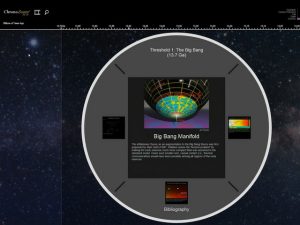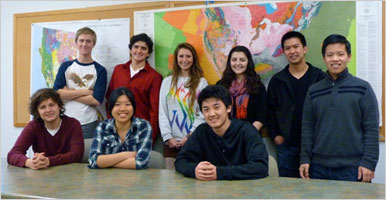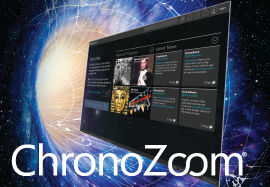Note: This project is retired and no longer supported, but is still available for use.
ChronoZoom is an open-source community project dedicated to visualizing the history of everything. Big History is the attempt to understand, in a unified, interdisciplinary way, the history of cosmos, Earth, life, and humanity. By using Big History as the story line, ChronoZoom seeks to bridge the gap between the humanities and sciences and enable all this information to be more easily understood and navigated.
Try ChronoZoom > (opens in new tab)
Seek
Take an epic voyage through time, infinitely scalable from the Big Bang to today, exploring history through this master timeline of the cosmos, Earth, life, and human experience
Learn
Gain insight from different historical perspectives, specialized timelines, and media resources, courtesy of the cloud
Create
Use ChronoZoom’s powerful authoring tool to create your own historical timelines that tell interdisciplinary stories spanning billions of years or just a few days
Discover
Explore unexpected relationships and historical convergences that help explain the sweep of Big History—and the relationship between the humanities and the sciences

ChronoZoom was developed to make time relationships between different studies of history clear and vivid. In the process, it provides a framework for exploring related electronic resources. It thus serves as a “master timeline” that ties together all kinds of specialized timelines and electronic resources and provides visual intersections of the humanities and the sciences.
You can browse through history on ChronoZoom to find data in the form of articles, images, video, sound, and other media. Equally compelling, ChronoZoom enables users to chronicle history by creating timelines that cover spans of history ranging from billions of years to just a day or two. ChronoZoom links information from five major regimes and unifies historical knowledge collectively into a map of Big History.
By drawing upon the latest discoveries from many different disciplines, you can visualize the temporal relationships between events, trends, and themes. Some of the disciplines that contribute information to ChronoZoom include biology, astronomy, geology, climatology, prehistory, archeology, anthropology, economics, cosmology, natural history, and population and environmental studies.
This project was funded and supported by Microsoft Research in collaboration with University California at Berkeley and Moscow State University.
-
We envision a world where scientists, researchers, students, and teachers collaborate through ChronoZoom to share information via data, tours, and insight. Imagine a world where the leading academics publish their findings to the world in a manner that can easily be accessed and compared to other data. Imagine a tool that allows teachers to generate tours specific to their classroom needs. This is the potential of ChronoZoom.
Big Questions
ChronoZoom is an incubation project that is being deployed in the spirit of “launch and learn.” Some big questions we have considered in developing ChronoZoom include:
- How do you organize huge amounts (terabytes and more) of different types of data (such as audio, video, text, PDF files, and images) logically and so they’re easily consumable?
- How do you retain precision while displaying historical information ranging from billions of years ago to today on one scale?
- How do you prioritize content when you have multiple items for the same time period? For example, an Egyptian history timeline, a Chinese cultural history timeline, an Islamic history timeline, a Japanese-American history timeline, and a particle physics timeline might all share a significant event on the same date in the year 1890—how do you display this on the timeline canvas?
- How do you efficiently draw elements on the canvas by using HTML Document Object Model (DOM) graphical elements and not sacrifice CPU usage?
- How do you ensure the same experience on multiple devices, operating systems, and browsers, so that users will have the exact same experience whether they use a Mac, PC, iPad, iPhone, Windows Phone, or Android device?
- How do you make a third-party authoring tool that is intuitive enough for middle-school students and rigorous enough for scholarly researchers?
- Should there be a bias toward author-built timelines or toward automated timelines that pull data from freely available datasets and libraries on the Internet?
- How do you compare multiple timelines and data sets?
- How do you retain the ambiguity of history? There are many interpretations of history, and much disagreement among experts about historical events; how do you ensure that students of history have access to the diverse historical information so that they can analyze it and develop their own interpretation of what happened?
Potential Future Features
Some of the possible future features could enable users to:
- Simultaneously edit a single timeline from various locations
- Generate internal user bookmarks
- Generate a chart dynamically to be placed on a timeline
- Display curve and segmented line graphs and plot events coded for magnitude
- Phylogenetic trees
- Svg drawing
- Filter exhibits based on subject
- Customize time direction up to down, down to up, left to right, right to left
- Compare data and timelines
- Share timelines or tours with others via social networking
- Display the uncertainty of dates (approximate dates)
- Show a time range in addition to a specific date in time
- Present multiple interpretations
- Display geo-spacial data
-
Microsoft Research and the ChronoZoom Project promote the establishment of relationships with academics and other partners (like publishers, researchers, museums, broadcasters, NGOs, foundations, and other organizations that have rich digital media content that crosses the sciences and humanities) to create valuable user experiences with this new technology. As data gets added to the platform, others can share access to enrich their experiences as well.
Get Involved
- Try ChronoZoom to learn about history or use it in the classroom.
-
ChronoZoom: An Infinite Canvas in Time
Inspiration
In early 2009, Roland Saekow decided to take the Big History course from Walter Alvarez at the University of California, Berkeley (UC Berkeley). Walter had created a series of timeline handouts created with a number of different methodologies. Fascinated, Roland was inspired to dedicate his student project to the study of timelines and thus sparked the inception of ChronoZoom as a way to examine the concept of Big History.
Roland and Walter began to discuss ideas for an interactive timeline application and often exchanged drawings on the blackboard after class or quick sketches during office hours. Walter soon began using Adobe Illustrator to create mockups with limited zoom capability, but quickly discovered that the current graphics applications did not have a fraction of the ability to zoom on the needed timescale.
Walter and Roland turned to the Office of Intellectual Property and Industry Research Alliances (IPIRA) at UC Berkeley, and put together a description of the project and rehearsed a demonstration of the prototype that they had built.
The response from IPIRA group was phenomenal. IPIRA helped Walter and Roland arrange a conference call with Microsoft Research. They produced a seven-minute video that explained both the Big History timescale problem as well as an initial prototype—and ChronoZoom was conceived.
IPIRA helped Walter and Roland arrange a conference call with Microsoft Research. They produced a seven-minute video that explained both the Big History timescale problem as well as an initial prototype—and ChronoZoom was conceived.
A small but highly dedicated team at Microsoft Live Labs produced the first version of ChronoZoom. It was capable of zooming from a single day all the way back to the Big Bang. This impressive accomplishment was achieved in time for Walter’s Faculty Research Lecture, where ChronoZoom made its worldwide debut. Walter had been selected as one of two faculty members to give the annual talk to the UC Berkeley community in 2010.
UC Berkeley wanted to create an intuitive, easy-to-use, dynamic cloud service that could have multiple data sets available. In the alpha attempt, we focused on an extensive back end that could handle hundreds of thousands of terabytes and multiple data types, but ultimately, the user interface was far too complicated.
The team changed focus to an intuitive user experience on a very easy-to-use tool and then expanded to include members of the humanities and science communities who were interested in using ChronoZoom for research and teaching.
The Journey to ChronoZoom Beta
The Microsoft Research Connections team helped establish the collaboration between the Microsoft Live Labs and UC Berkeley teams. With an investment in a dedicated engineering effort as well as funding for student contributions, the next phase of ChronoZoom was secured.
It was agreed that Berkeley would continue to be the primary visionary of the project, but would take on an additional role of content management. The power of ChronoZoom would only be evident if the content and the stories they told were compelling, and so a group of students were employed to research, collect, analyze, and finally create the content elements inside the ChronoZoom beta version.
The Live Labs team at Microsoft had been disbanded and so the project was in need of new technical leadership. The Microsoft Research Connections organization had been growing their own top-notch engineering team, and this team brought to bear more than 50 years of collective software development experience to the effort.
As the project goals and strategy unfolded, we knew that we needed to react to changes in the technical strategy in the market if we wanted it to have a viable future. The solution was to rebuild ChronoZoom from the ground up to take advantage of the power of Windows Azure for flexibility and scalability on the back end with HTML 5 and rich UI client technology to support the demands of a complex, infinite-zoom canvas and interface. We learned that ChronoZoom needed to focus on scalability and user interface.
The decision to use HTML 5 had its share of drawbacks, and ultimately resulted in the need to re-evaluate the resource needs and skillsets required. We had a number of challenging obstacles to overcome. To fully realize the concept of ChronoZoom, developers had to create complicated math algorithms that could manage dynamic timeline behaviors as well as difficult scenarios such as leap years, no year 0, and Before Common Era timeline.
We contacted the development team from Moscow State University and these students greatly helped advance the project during the latter half of 2011. They learned HTML 5 and how to integrate Jscript to produce quality animations and functionality. The team was fortunate to have the opportunity to bring on a new set of highly skilled student developers from Lomonosov Moscow State University. The complexity from both a technical and usability standpoint is immense in this project, and what might seem like a relatively short development cycle was pre-empted by a lot of hard work, re-work, and sometimes starting over. The philosophy we have used is to iterate regularly, obtain feedback at every chance, and to consider design and usability as a first priority. As a result, ChronoZoom beta is ready for mass consumption and feedback, structured to scale up to petabytes of content, and architected for the future of personal computing.
“With ChronoZoom, you can browse history, rather than digging it out piece by piece.”
—Walter Alvarez, Department of Earth and Planetary Science, University of California, Berkeley
-
ChronoZoom: An Infinite Canvas in Time
Q. Why does the animation appear slow or jittery on my computer?
A. ChronoZoom is designed to support computers that meet the hardware requirements for browsers that support HTML 5. On some computers, the graphics may be slower or less smooth than intended due to limited memory, processor power, or graphics capability.
Q. Why don’t the graphics perform well in Firefox 10.x?
A. Firefox 10.x automatically activates hardware graphic acceleration even if the computer doesn’t have a graphics adapter that can support this functionality. We recommend disabling the Firefox hardware graphics acceleration.
-
ChronoZoom Contributors
The following important contributors have made ChronoZoom possible.
Project Management and Community Outreach
- Rane Johnson
Project Managers
- Michael Zyskowski
- Bob Walters
Developers and Testers
- Danny Datal – development manager
- Kal Viswanathan – lead developer
- Roman Snytsar – test manager
- Palani Vairavan – developer
Moscow State University development and test team:

Dr. Sergey Berezin, Alexander Zenchenko, Anna Isaeva, Dmitry Grechka, Dmitry Voytsekhovskiy, Eugene Nourminsky, Ivan Samylovskiy, Michael Kalygin, Nataliya Stepanova, and Nikita Skoblov
ChronoZoom Content
University of California at Berkeley content team:

Dr. Walter Alvarez, Roland Saekow, Chris Engberg, Michelle Lo, Ken Zhou, Matt Hoffman, Robbie Bruens, Madison Allen, Sergey Piterman, Cecily Gardner, Kenneth Leung, and David Shimabukuro
User Experience and Collected Materials
- Jessica Herron
- Chris Engberg
- Jason Andrew
- Paul Secord
ChronoZoom Project Advisors
Eric J. Chaisson, Harvard University; Barry Rodrigue, University South Maine; Lowell Gustafson, Villanova University; Craig Benjamin, Grand Valley State University; Fred Spier, Amsterdam University; David Christian, Marquarie University; Ian Sands, Michael Dix, Greg Amrofel, and Andy Cook of the Gates’ Big History Project; Cynthia Brown, Dominican University; Mojgan Behmand, Dominican University of California; Dominican University of California Big History First Year Expeerience Faculty; Jo Guldi, Harvard University; Jerry Bentley, University of Hawaii; Patrick Manning, University of Pittsburgh; William Turkel, University of Western Ontario; Bill Crow, Microsoft; Curtis Wong, and Steven Drucker, Microsoft Research; Jian Zhao, Microsoft Research Intern; Donald Brinkman, Microsoft Research Connections; and Philippe Claeys, Université Libre de Bruxelles
Corporate and Institutions
- Microsoft Research FUSE Labs
- Outercurve Foundation
- University of California at Berkeley
- Moscow State University
- University of Washington
- Dominican University
- Big History Project
- Lake Washington High School
-
- A new tool for teaching climate change in the cloud
- On the Road with ChronoZoom
- Presenting the History of Everything
- An Infinite Canvas in Time: Visualizing the History of Everything (PDF)
- ChronoZoom Overview (PDF)
Related links
- Outercurve Foundation
- ChronoZoom at University of California, Berkley
- Windows Azure
- Zoom In, Zoom Out
Contact us
If you are interested in learning more and joining the ChronoZoom project, please contact Roy Zimmermann.

